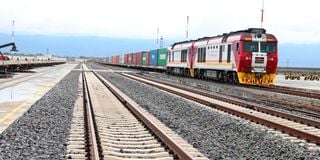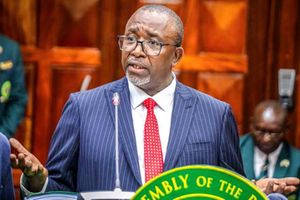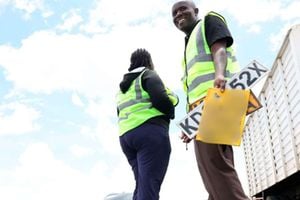Premium
Prioritising funding of SGR to Malaba is Kenya’s duty to Africa

Chinese loans to finance SGR projects is a bitter but necessary pill to swallow.
It is now official. President William Ruto will make his maiden visit to Beijing to attend the Third Summit to mark 10 years of the Belt and Road Initiative in mid-October, 2023.
Under China’s multi-trillion dollar infrastructure project, Beijing agreed to fund the Mombasa-Malaba Standard Gauge Railway poised to position Kenya as a communication hub in Eastern Africa.
But ahead of the high-stakes General Elections in August 2022, China’s debt was intensely weaponised in response to President Uhuru Kenyatta’s support of the Opposition chief, Raila Odinga.
Lampooned as ‘a railway to nowhere’, Kenya’s railway project stalled. The African dream of building a trans-continental railway network linking the Indian and Atlantic Oceans was deferred.
The 2022 political guns are now silent. As President William Ruto travels to Beijing, China’s funding for the stalled Suswa-Kisumu-Malaba section is Kenya’s unfinished and urgent agenda. It is the country’s debt to the continent.
In his premier visit to Beijing, Dr Ruto will meet his Chinese counterpart President Xi Jinping. Certainly, the flight to Beijing will be long long. I humbly recommend the book: Adam Smith in Beijing (2007) by the Italian economist Giovanni Arrighi for the President and his entourage of foreign policy pundits.
I have a reason. Ruto, who appeared to have jettisoned Kenya’s ‘Look-East’ policy of the Kibaki-Uhuru era and actively shifted to a ‘Look West’ pro-American foreign policy is, obviously, an odd visitor to Beijing.
Adam Smith (1723–1790), a Scottish economist and author of the classic Wealth of Nations (1776), who is elebrated as the father of modern economic thought, would have been an atypical visitor, too. Arrighi’s book is a sobering story of how nations are ‘naturally’ and ‘peacefully’ creating wealth in the 21st century beyond geopolitics, dogma the hubris of elite politicking.
Kenya cannot ignore China, its largest trading partner and largest bilateral creditor. In Beijing, Ruto has a twofold agenda: to secure $1 billion (Ksh150 billion) from Beijing to fund stalled projects and negotiate a credit service for previous loans. The latter is possible. In February 2021, as the country struggled with the economic impact of the Covid-19 pandemic, China postponed $245 million of Kenyan debt repayments for six months.
Weaponisation of China debt
But the weaponisation of Chinese debt to Kenya in the heat of the 2022 presidential campaign will haunt the first agenda.
Already critics are speaking of Ruto’s ‘begging bowl’, arguing that more Chinese loans will increase government borrowing — which has risen from Sh8.63 trillion in June 2022 to Sh10.25 trillion in June 2023 .
But with the Kenya shilling on a free-fall against the dollar, the cost of living rising and electoral promises to the ‘hustlers’ still unmet, Chinese loans is a bitter but necessary pill to swallow.
China channels its development assistance through the Belt and Road Initiative (BRI), humanity’s most ambitious and impactful infrastructure project.
As of October, 155 countries and 32 international organisations have signed to the initiative, which has implemented more than 3,000 projects globally worth over one trillion dollars.
According to a recent World Bank report, BRI transport projects could increase trade between 2.8 percent and 9.7 percent and contribute to lifting 7.6 million people from extreme poverty.
Since 2014, Kenya has been Africa’s top beneficially of the Belt and Road open-ended credit line to fund its 1,300km Mombasa-Malaba SGR. Nairobi borrowed a total of Sh656.1 billion ($5.1 billion) in three tranches for the construction of the two phases of its signature railroad.
But at about 600kms, the Mombasa-Naivasha SGR is 400km shy of the 1,000km needed to make the line economically viable by international standards. Moving forward, Sino-Kenya talks should focus on the stalled the Naivasha-Kisumu and Kisumu Malaba sections of the railroad.
In the run-up to the 2022 polls, Beijing’s loans to Kenya were sensationalised as ‘debt-trap diplomacy’ and a ‘form of neocolonialism’.
Sections of local and international press as well as academics and politicians aligned to President Ruto embarked on an intense media campaign against the “railway to nowhere’. Both Presidential Adviser David Ndii and the Defence Minister described it as “the most expensive and inefficient infrastructural project.”
Beyond the 2022 politics, the Mombasa-Malaba SGR railway is ‘a railway to prosperity’. It is Kenya's largest infrastructure project since Independence and the flagship project of Kenya Vision 2030. Second, it is an integral part of the East African Railway Master Plan to rejuvenate the railways serving the region.
Finally, it carries the African dream of building modern trans-continental railway networks to boost inter-African trade, mobility and integration. Kenya should prioritise funding to complete Naivasha-Malaba section of the ‘railway to prosperity’ as its duty to Africa.
- Prof Peter Kagwanja is chief executive at the Africa Institute and author of forthcoming book: A Railway to Prosperity: The Geo-Politics of Kenya’s High-Speed Railway, (Tafiti House Publishers: October, 2023).





